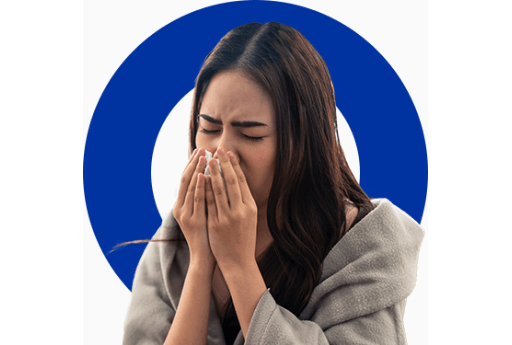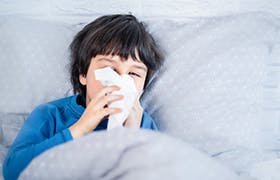
Common cold symptoms to look out for.
Cold symptoms vary from person to person. Many of the symptoms that make a person feel ill during a cold actually result from the activities of the immune system trying to eliminate the cold virus from the body.3
You’ll know you’ve caught a cold if you begin to experience symptoms including a sore throat, cough, tiredness, sneezing or a blocked nose.1 Having a blocked nose can be one of the most annoying symptoms of a cold, since it makes the simple act of breathing more difficult, and can result in a lack of sleep or disrupted sleep patterns.7
Let’s look at the common cold symptoms in more detail:4
- Blocked nose: this is a later symptom in the development of a cold and it typically gets worse during the first week of symptoms.
- Runny nose: this is an early symptom of the common cold and can cause sneezing.
- Sore throat: throat irritation (a dry scratchy sensation) is an early symptom of the common cold and may develop into a sore throat.
- Sneezing: this is triggered by the nasal congestion and runny nose that come with a cold.
- Cough: this is often a dry cough that can cause loss of sleep and exhaustion.
- Tiredness: the common cold can make you feel tired and lacking in energy. You might also feel less alert than usual.
Generally, you’ll start to feel cold symptoms between one and three days after infection with a cold virus, and they should reach a peak of severity within two to three days. Symptoms will start to taper off after seven days. But do remember, you can be contagious before you start to feel ill and for some time afterwards.1
- Days 1–3: You might feel more tired than usual and feel the first signs of a sore throat (perhaps just an itchy throat) and you’ll probably start sneezing.
- Days 3–5: You may start to notice that your nose is blocked, being at its worst on days 3 and 4. You may also have a runny nose and a cough. Often the cough may linger for a few weeks after the blocked nose and other cold symptoms start to go away.
- Days 6–7: You should be starting to feel better and most of your symptoms will be clearing up.
- Days 7-10: If you still have symptoms after 7–10 days or your symptoms start to worsen, speak to your doctor so they can rule out other causes, such as a sinus infection or allergies.1
What are the differences between cold and flu symptoms?
If you’ve found yourself wondering, “what are the symptoms of flu and how do they differ from a cold?” look no further. The main differences between cold and flu symptoms are summarised in the table below.5
| Nasal discharge and congestion | Common | Rarely |
| Fever | Rare, mild | Yes (38-40 °C), sudden onset |
| Sore throat | Common, mild dry, scratchy, sore | Sometimes |
| Cough | Mild-to-moderate (dry at the beginning; often becomes productive as the cold progresses) | Common, non-productive |
| Headache | Rare, via sinus congestion | Yes |
| General aches and pain | Rare, mild | Common (myalgia) |
| Other | Sneezing in the first couple of days | Fatigue, weakness, chills |
| Duration | Usually 5-7 days, but 25% last 14 days | 10 days |
| Cause | Viral | Viral |
What treatment can I take to relieve my cold symptoms?
Common cold is managed mainly with symptomatic management to get relief of symptoms.1
Avoid antibiotics when treating cold symptoms, since they’re ineffective against a virus, unless advised by your Physician for a specific reason. Make sure to rest, eat healthy and drink plenty of liquids. Basic good hygiene practices, such as regular hand-washing, will help reduce the spread of the virus to other people.1
Having a blocked nose can be one of the most irritating cold symptoms, but thankfully there are blocked nose treatment options available. They include nasal irrigation, steam treatments, or nasal decongestant sprays like Otrivin.1
The following healthy habits can help while you have a cold:1
- Make sure to get enough rest, but there’s no need to stop normal everyday activities such as working or school – they won’t make a cold worse
- Eat healthy foods
- Drink lots of fluids
- Wash your hands frequently
- Don’t share towels, toys or other objects

Reach for Otrivin as part of your blocked nose treatment.
When you’re suffering from a cold, you’ll likely do just about anything to get rid of it. Luckily, Otrivin has a range of nasal decongestant sprays and drops for you to consider depending on your needs and symptoms, including:
- Otrivin Oxy Fast Relief Nasal Spray, which starts to unblock your nose in just 25 seconds and provides relief for 12 hours.2,8,6
- Otrivin Paediatric Nasal Drops, which help to unblock your child’s (ages 1-11 years) congested nose and get to work in just 2 minutes and provides relief up to 12 hours. 9,10,11
- Otrivin Saline Nasal Spray, which helps to wash away excess mucus produced during a cold.12
- Otrivin Baby Saline Nasal Spray, which helps to provide relief from congestion in infants and toddlers.13
- Otrivin Moist P Nasal Drops14, helps to provide relief from congestion, and provide further moisturisation to the nasal passage. It starts working in 2 minutes and provides relief up to 12 hours.
- Otrivin Breathe Clean should be adopted as a daily hygiene habit. It is a nasal wash that helps to clean pollutants, germs, and allergens from the nasal passage, thus maintaining nasal health.16
You should always ask your doctor, which Otrivin product is best suited for your condition before initiating a treatment.
References:
- NICE CKS. Common cold. Available from: https://cks.nice.org.uk/common-cold#!background (last accessed March 2020)
- Reinecke S & Tschaikin. Investigation of the Effect of Oxymetazoline on the Duration of Rhinitis. MMW-Fortschritte der Medizin Orginal Reports No III/2005; 147:113-8.
- Drexler M. What You Need to Know About Infectious Disease. Institute of Medicine: National Academies Press (US); 2010. Available from: https://www.ncbi.nlm.nih.gov/books/NBK209710/ (last accessed March 2020)
- Eccles, R. 2009. Mechanisms of symptoms of common cold and flu. In Common Cold, Eccles & Weber, eds. Basel, Birkhäuser, 2009;23–45
- Thirion DJG. Assessment of patients with upper respiratory tract symptoms. 2016. Available from: https://www.e-therapeutics.ca/print/new/documents/MA_CHAPTER/en/ (last accessed March 2020)
- Otrivin Oxy Fast Relief Product Information Leaflet
- Nasal Congestion (Blocked Nose) | Patient
- Global Datasheet Oxymetazoline
- Global Datasheet Xylometazoline
- Eccles R & Eriksson M. The nasal decongestant effect of xylometazoline in common cold. Am J of Rhinol 2008; 22(5); 491-6.
- Otrivin Paediatric Nasal Drops Product Information Leaflet
- Otrivin Saline Nasal Spray Product Information Leaflet
- Otrivin Baby Saline Product Information Leaflet
- Otrivin Moisturising Adult Nasal Drops Product Information Leaflet
- Otrivin Moisturising Paediatric Nasal Drops Product Information Leaflet
- Otrivin Breathe Clean Product Information Leaflet
Show all references
Close references










